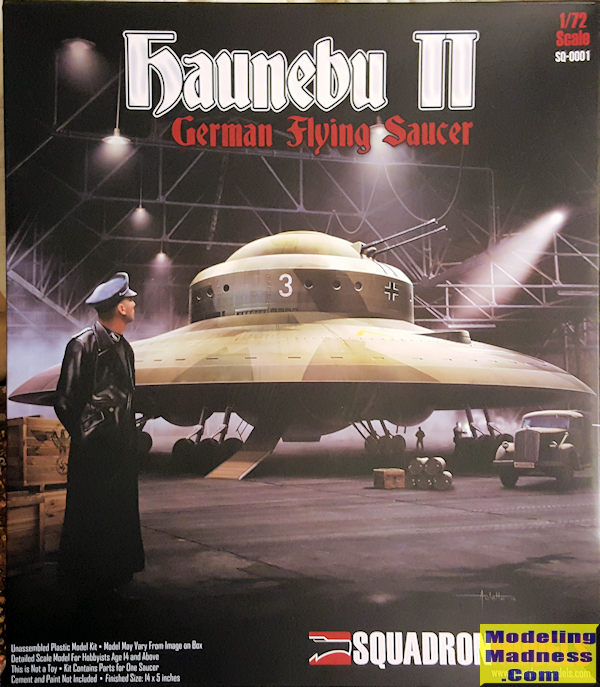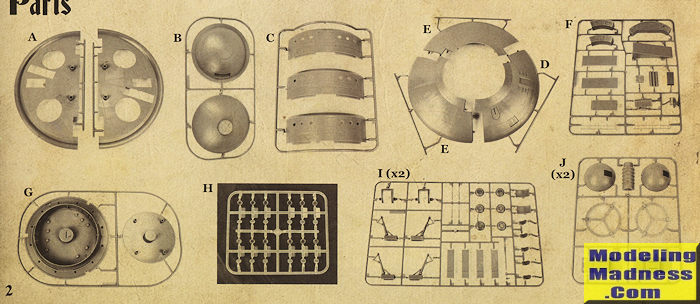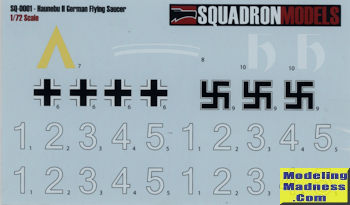
Squadron Models 1/72 Haunebu II
| KIT #: | SQ-0001 |
| PRICE: | $79.99 MSRP |
| DECALS: | Five options (different numbers) |
| REVIEWER: | Scott Van Aken |
| NOTES: | New tool kit (2017) |

| HISTORY |
In UFOlogy, conspiracy theory, science fiction, and comic book stories, claims or stories have circulated linking UFOs to Nazi Germany. The German UFO theories describe supposedly successful attempts to develop advanced aircraft or spacecraft prior to and during World War II, and further assert the post-war survival of these craft in secret underground bases in Antarctica, South America, or the United States, along with their creators. According to these theories and fictional stories, various potential code-names or sub-classifications of Nazi UFO craft such as Rundflugzeug, Feuerball, Diskus, Haunebu, Hauneburg-Gerät, V7, Vril, Kugelblitz (not related to the self-propelled anti-aircraft gun of the same name), Andromeda-Gerät, Flugkreisel, Kugelwaffe, and Reichsflugscheibe have all been referenced.
Accounts appear as early as 1950, likely inspired by historical German development of specialized engines such as Viktor Schauberger's "Repulsine" around the time of World War II. Elements of these claims have been widely incorporated into various works of fictional and purportedly non-fictional media, including video games and documentaries, often mixed with more substantiated information.
German UFO literature very often conforms largely to documented history on the following points:
By 1944, the Haunebu II Do-Stra (Dornier STRAtospharen Flugzeug/Stratospheric Aircraft) was tested. Two prototypes were built. These massive machines, several stories tall, were crewed by 20 men. They were also capable of hypersonic speed beyond 21,000 km/h. The SS had intended to produce the machines with tenders for both Junkers and Dornier but in late 1944/early 1945 Dornier was chosen. The close of the war, however, prevented Dornier from building any production models. Yet larger still was the 71 meter diameter Haunebu III. A lone prototype was constructed before the close of the war. It was crewed by 32 and could achieve speeds of 7,000 to 40,000 km/h. It had a triple Victalen hull. It is said to have had a flight endurance of 7 to 8 weeks. The craft made 19 test flights. This craft was to be used for evacuation work for Thule and Vril in March 1945
| THE KIT |
 This is the
first of a line of Squadron's own kits and I have to say they certainly picked
an interesting subject with which to begin. Let me get some specs out of the
way. There are 125 parts in a VERY large box. The finished model will measure 14
inches across so it is not exactly something small.
This is the
first of a line of Squadron's own kits and I have to say they certainly picked
an interesting subject with which to begin. Let me get some specs out of the
way. There are 125 parts in a VERY large box. The finished model will measure 14
inches across so it is not exactly something small.
Molding is first rate and everything you'd expect from a modern plastic model kit. The main cabin is fully detailed with nine crew seats along with their various consoles. This all fits onto a piece that will later be installed into the lower saucer section. The kit does, however, start you out with th elower piece. This is in two halves and has a number of openings for boarding ramps, landing gear, and lower gun turrets. One can model the boarding ramps raised or lowered. The same is true of the landing gear, however, you'll have to devise a stand.
Back at the interior, there are also detailed walls which are three interconnecting pieces. Clear windows are provided and there are detail pieces for the walls. There are four lower turrets, each with twin guns. The turrets are designed to rotate and the guns can be depressed. Once the lower hull is mostly built, one then starts working on the large three piece upper saucer section. This has an opening in the top for the cabin walls to be inserted. The upper saucer section also has a single turret on the top for the two big guns. Like the lower turrets, this can be rotated though the main guns are fixed. The upper turret is designes so that removing it from the completed model will show off the interior.
All of this is held up by four landing gear assemblies. Each assembly has dual struts and consists of a three wheel lower section. These are designed so they can be installed after the model is painted, a big help on a project like this.
 Instructions
are superb and are a CAD style format that clearly shows what goes where. All
the color information is in Vallejo paint numbers, but generic and RLM
information is also provided. The one machine is shown in an overall splinter
pattern of RLM 78/74/62 and will require a bit of masking skill, though it isn't
anything an intermediate modeler will not be able to accomplish. Of course, one
can always paint it as one sees fit. The decal sheet is printed by Cartograf and
provides a nice selection of insignia and five numbers.
Instructions
are superb and are a CAD style format that clearly shows what goes where. All
the color information is in Vallejo paint numbers, but generic and RLM
information is also provided. The one machine is shown in an overall splinter
pattern of RLM 78/74/62 and will require a bit of masking skill, though it isn't
anything an intermediate modeler will not be able to accomplish. Of course, one
can always paint it as one sees fit. The decal sheet is printed by Cartograf and
provides a nice selection of insignia and five numbers.
| CONCLUSIONS |
Prior to this there has been only one kit of this of which I am aware, and that is a smaller kit by Wave. Judging by the photos I have of this vehicle in my references, this one is more accurate and I'm sure the 'red line' folks will agree with me on this. It is the sort of thing that has a lot of appeal and while it will not be a quick build, it will surely be something that will stand out in any collection. An absolute must for those who like flying saucers and similar types.
As another note, I highly recommend the low budget 2012 movie 'Iron Sky'. It is based on all this and a very well done dark comedy. You can find a clip of the film by using Google.
| REFERENCES |
https://en.wikipedia.org/wiki/Nazi_UFOs
http://www.bibliotecapleyades.net/ufo_aleman/esp_ufoaleman_3.htm
Copyright ModelingMadness.Com. All rights reserved.
Thanks to www.squadron.com
for the preview kit. You can find this kit at
this link. If you would like your product reviewed fairly and fairly quickly, please
contact
the editor or see other details in the
Note to
Contributors. Back to the Main Page
Back to the Review
Index Page
Back to the Previews Index Page